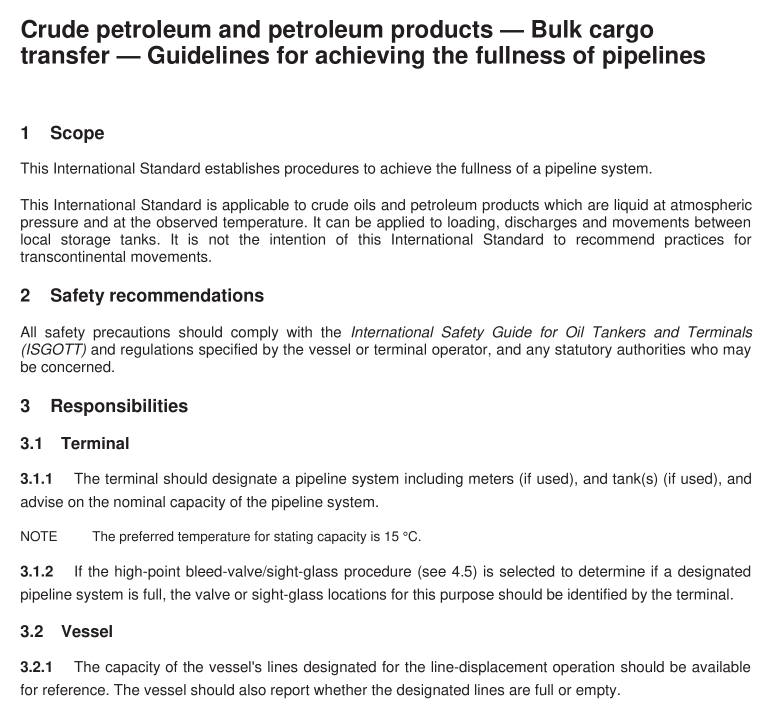BS ISO 11563 pdf download

BS ISO 11563 pdf download Crude petroleum and petroleum products — Bulk cargo transfer — Guidelines for achieving the fullness of pipelines
1 Scope
This International Standard establishes procedures to achieve the fullness of a pipeline system.
This International Standard is applicable to crude oils and petroleum products which are liquid at atmosphericpressure and at the observed temperature. lt can be applied to loading, discharges and movements betweenlocal storage tanks. It is not the intention of this international Standard to recommend practices fortranscontinental movements.
2Safety recommendations
All safety precautions should comply with the International Safety Guide for Oil Tankers and Terminals(ISGoTT) and regulations specified by the vessel or terminal operator, and any statutory authorities who maybe concerned.
3Responsibilities3.1Terminal
3.1.1 The terminal should designate a pipeline system including meters (if used), and tank(s)(if used), andadvise on the nominal capacity of the pipeline system.
NOTE The preferred temperature for stating capacity is 15 °℃.
3.1.2 lf the high-point bleed-valve/sight-glass procedure (see 4.5) is selected to determine if a designatedpipeline system is full, the valve or sight-glass locations for this purpose should be identified by the terminal.3.2Vessel
3.2.1The capacity of the vessel’s lines designated for the line-displacement operation should be availablefor reference.The vessel should also report whether the designated lines are full or empty.
3.2.2The condition of the vessel’s lines will have a direct effect on the accuracy of the line-displacementprocedure between the vessel and the shore. The vessel should provide every assistance to accuratelydetermine the fullness condition of the vessel’s lines.
4Procedures
4.1General
The following procedures are described in this International Standard:
a)line displacement between the vessel and the shore,see 4.3;
b)internal circulation of shore lines, see 4.4;
c)high-point bleed-valve/sight-glass procedure, see 4.5;
d) pigging of shore lines, see 4.6;
e) line press (line pack), see 4.7.
Procedures b), c), d) and e) do not require the presence of a vessel.
4.2 Agreed tolerance
Parties should agree on the differences in volumes or tank levels, determined at the commencement andcompletion of a line-fullness procedure,that will be acceptable.Such differences are referred to as the”agreed tolerance”.
NOTE1 Agreed tolerances can be derived from consideration of the nominal precision of the measurement techniquesemployed. In addition, records of previous line-fullness operations at a particular terminal can provide details to assistarriving at the agreed tolerance.
NOTE2 For the line-press procedure, a typical agreed tolerance would be a 3 mm difference in tank level,
4.3Line displacement between vessel and shore
4.3.1 This procedure consists of measuring the amount of liquid pumped from a shore tank to a vessel (orfrom a vessel to a shore tank) through the pipeline system designated for cargo transfer, and comparing thetotal observed volume(TOV) delivered to the TOV received. In some cases, for instance where temperaturesof liquid in lines and tanks ‘differ considerably, comparison of volumes corrected from the observed,TOV,condition may be necessary. lf free water (FW) can be ignored, comparison using the gross standard volume(GSV) is satisfactory. If free water is present, comparison by the total calculated volume (TCV), namely Gsv +Fw, should be used. The parties involved should agree prior to the displacement on the comparisonprocedure adopted.
4.3.2 The vessel should either be on even keel with no list, or a trim correction or wedge calculation shouldbe applied.
4.3.3 All cargo quantities on board and the shore tank quantity should be determined prior to linedisplacement.
4.3.4 The number of vessel tanks used for the line displacement should be kept to a minimum and beselected to minimize changes in trim or list (preferably one centre tank).
4.3.5 Obtain the fullness condition of the vessel lines before and after the displacement operation.4.3.6Obtain the nominal capacity of the shore pipeline system.
4.3.7 Agree on the quantity to be displaced.The displacement should be stopped when the TOV of productis at least 120 % of the combined capacity of all designated vessel and shore transfer pipelines. Calculate astop gauge for the designated vessel or shore tank(s) to meet the agreed volume.
4.3.8Agree on the flow rate.
4.3.9 Ensure proper coordination between the vessel and the shore to enable, for example, correct valvesettings.
4.3.10 Record metered volumes or measure liquid levels in the tank and, as necessary, temperature and freewater in delivery and receiving tanks, to derive ToVs or GsVs or TCVs as required.
4.3.11 Transfer the volume required for displacement between the vessel and the shore.
4.3.12 Record metered volumes or redetermine liquid levels in the tank and, as necessary, temperature andfree water in the delivery and receiving tanks to provide TOVs or GsVs or TCVs as required.









